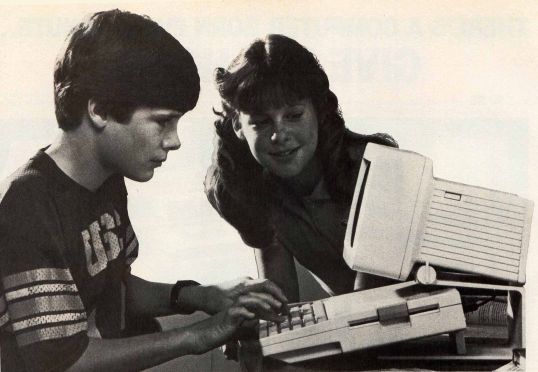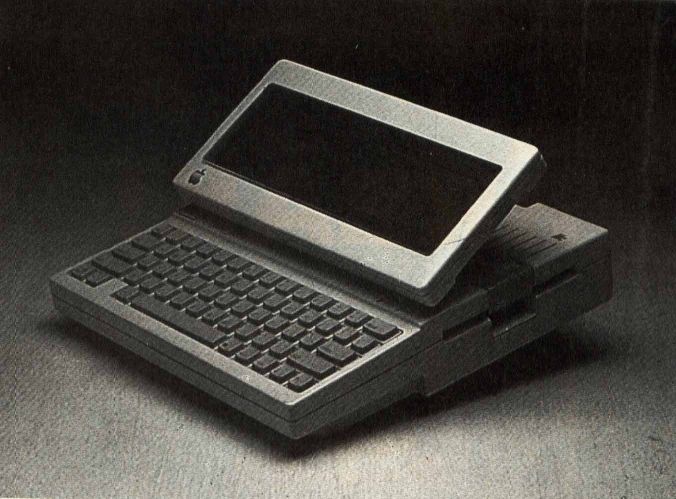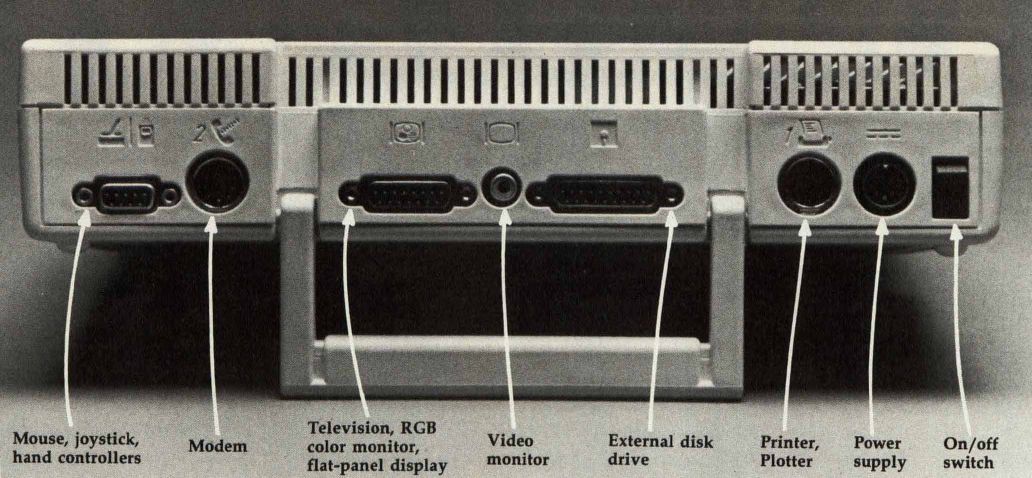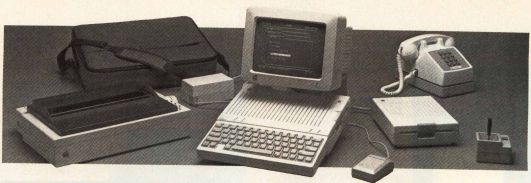Evolutionary To The Core:
The Apple IIc Heads For Home
Selby Bateman, Features Editor
Apple Computer has made 1984 its year of surprises, first with the "revolutionary" Macintosh and now with the "evolutionary" Apple IIc. The new 7½-pound portable has already achieved critical acclaim and impressive early sales. Is it the computer for you?
"The IIc is not a home computer," says Apple President John Sculley. "It's for the serious user in the home."
Sculley isn't just playing word games with that comment. It is as succinct a statement of Apple's plans for the IIc as you'll find. And it addresses the biggest challenge and the greatest opportunity for the Cupertino, California, company: To convince a huge untapped home market that the IIc is not a low-end computer. And at the same time, Apple is targeting owners of low-end microcomputers who want more power, more software, and more portability.
$15 Million In Advertising
By now you may have heard or read something about the IIc's power (128K RAM), price ($1295), portability (notebook size, 7½ pounds, built-in low-profile 5½-inch disk drive), and compatibility (it runs thousands of Apple II software programs). And you've probably seen some of the $15 million in advertising that Apple has spent these past few months.

Still, for most people, the important question is: What is Apple offering you in the IIc that you can't get with the IBM, Commodore, Atari, Radio Shack, and other Apple computers?
If market researchers are correct, the number of personal computers in the home will go up from eight million units now to about 50 million by 1988. This would put at least one computer in two out of every three U.S. households in the next four years.
Two Steves In A Garage
To see how Apple plans to exploit that potential market with its new IIc, you have to go back to 1977. Two young men, Steve Jobs and Steve Wozniak, emerged from their garage workshop with the Apple II, the first fully assembled personal computer. It created a sensation, and the two Steves haven't looked back since. The Apple II begat the Apple II+, which begat the Apple III—a business machine. Then, in 1983, the company introduced the Apple IIe (the e stands for enhanced), a 64K RAM personal computer which continued the evolution of the Apple II line. Almost two million computers in the Apple II family have been sold.
At that point the problems started. Or as John Sculley puts it: "The Apple IIe was a very important technical improvement on the Apple II+, but the real difference in 1983 was that for the first time, the Apple II faced real competition."

Apple found itself sandwiched between the low price of the Commodore 64 (and several other low-end computers) and the IBM PC, which quickly established itself as a high-end standard.
"While IIe sales continued to grow," Sculley said, "Apple was quickly becoming positioned as a single-product company with declining importance in business and in the home. That's a very dangerous situation."
The First 100 Days Of The Macintosh
But what a difference a year makes. With the introduction of the Macintosh in January of this year, Apple offered a revolutionary personal computer aimed primarily at the business and college markets. It was designed to be the least intimidating and easiest to use computer on the market. The $2495 128K computer, which has no built-in programming language and features a mouse input device, sold more than 70,000 units in its first 100 days.
By contrast, the original Apple II took 2½ years to sell 50,000 units, and the IBM PC took over 7½ months to sell the same number.
Then, this April, Apple introduced the IIc at a day-long exposition in San Francisco. The event featured a high-tech sound and light show, demonstrations of the new product, presentations of compatible software from a variety of companies, and an unplanned earthquake that rocked the city. Within several hours that day, Apple took more than 50,000 IIc orders from more than two thousand retail dealers. Apple had come some distance from two young men in a garage.
Just Another Appliance
Amidst the carnival hoopla of the IIc's debut, Apple officials restated their argument that the new machine is an evolutionary twist in the Apple II line and that it addresses a new segment of the buying public with a different concept of what a computer should be.
"We should not be judging how convenient the Apple IIc is versus other competitors," says Sculley, "but relative to other consumer appliances that are used by people who have never used any personal computers before. The IIc was designed from the start to demystify the intimidation that personal computers present to so many people." In other words, as with the Macintosh, Apple is trying to make the IIc as easy to use as a toaster, a television, or a stereo system. And the company is trying to do that in the same way that items such as cars, cameras, and pocket calculators have evolved into mass market products.
Apple estimates that about two-thirds of IIc sales will be to the home market, with the rest going to schools and small businesses.
The Snow White Look
To underscore the novelty of the IIc, Apple has altered the physical appearance of the new machine and all of the optional peripherals that are made for it. The new look is called "Snow White," and it features an ivory color, rounded corners, and a sleek, narrow case with a fine-grained texture. Frog Design, a West German firm which also designed the Sony Walkman, created the new casing for Apple. It marks the biggest exterior design change in the Apple II line, and will be the look of all future Apple products.
The computer, including the keyboard, internal circuit board, built-in disk drive, and rear panel peripheral ports, weighs only about 7½ pounds. A recessed handle mounted on the top rear of the computer swings out for carrying and also locks in place in order to position the machine at a correct typing angle. The body of the computer is only 2½ inches high, 12 inches wide, and 11½ inches long—little more than the size of a notebook.
To emphasize the IIc's simplicity, everything a user needs to get started comes in one box, except a display screen. The absence of a monitor with the new computer will allow consumers to choose between television, composite monitor, and RGB (red-green-blue) displays. And, by September, a new flat liquid crystal display will be available, says Steve Jobs, Apple's chairman of the board. It also keeps the initial price lower and allows dealers to sell the computer in a variety of configurations.

There aren't any ROM cartridge slots either. Jobs calls those cartridges clumsy, and prefers the cheaper, more effective, and more flexible floppy disks.
70 Fewer Chips
Internally, the IIc has a 65C02 central processing unit (CPU)—an eight-bit microprocessor—which Apple says is an enhanced version of the 6502B CPU used by the Apple IIe. Both of those chips are based on the original 6502 manufactured by MOS Technology. The C in 65C02 is taken from CMOS (Complimentary Metal-Oxide Semiconductor), which designates the production process of the chip. The new version reportedly has cooler operation and requires less power, allowing the IIc to use a battery pack that is to be available later.
The 65C02 chip also reportedly includes 27 new programming instructions. If programmers use these instructions in their IIc software packages, those programs will not work on earlier Apple II models with the original 6502 or 6502B chip. Upward compatibility from the earlier Apple II machines to the IIc is not a problem, however, Apple says.
There are only 40 chips within the IIc, quite a reduction from the 110 which are found in the IIe. Apple engineers combined the functions of some chips onto custom large-scale integrated chips to achieve this. They also combined functions: The mouse peripheral port on the rear of the unit, for example, can accept a mouse, joystick, or hand controllers. Although there are fewer chips, the machine has double the usable memory of the Apple IIe—128K, or the equivalent of about 50 double-spaced typed pages of work area. There is 16K of ROM (Read Only Memory), containing among other things the standard Applesoft BASIC programming language.
Ultrahigh Resolution
There are three graphics modes available with the IIc. First, a low-resolution graphics mode of 40 × 48 pixels with 16 available colors and, second, a high-resolution mode of 280 × 192 with 6 colors—both of which are comparable to the IIe's graphics modes. The IIc also has an ultrahigh-resolution monochromatic mode of 560 × 192, which approaches but does not match the Macintosh's 512 × 342 pixel monochrome display. Apple says that in the future the ultrahigh-resolution mode will be able to support 16-color graphics.

The IIc also has an internal speaker almost identical to that in the IIe. It allows five octaves of sound. The IIc has a volume control button on the side of the case, which the IIe does not. And there is a plug for headphones in the new machine, next to the volume control button.
The keyboard on the IIc represents a departure from the IIe, although the basic layout and size are virtually identical. There are 63 sculpted keys, but rather than the smooth up and down action of the IIe, the IIc's keys have a breakover effect—a definite toggle—that gives a tactile sense when a key has been hit as well as an audible click. The effect is not unlike the keyboard action on the IBM PC, although the breakover action on the IIc is not as pronounced.
Spillproof
Above the keyboard, starting on the left, are three partially recessed switches: a rectangular reset button, which on the IIe is to be found on the right side of the keyboard; a button that changes the video display from 40 to 80 columns (or vice versa) for text; and another button which will alter the keyboard from the standard QWERTY key configuration found on most typewriters to a DVORAK keyboard. The DVORAK keyboard, which has a faster and more logical key layout than QWERTY, is growing in popularity. Apple will also have replacement key caps for those who wish to install them in the DVORAK layout.
An Apple spokesperson says that six different keyboard prototypes were tested for the IIc, and that on the recommendations of touch typists who tested the various keyboards, the present style was adopted.
Another interesting keyboard feature is a layer of plastic beneath the keys, which will prevent any spilled liquids from penetrating into the computer itself. At typing angle, liquids will drain toward air vents at the front of the machine. An Apple spokesperson called this the "drool" cover.
Foolproof Peripheral Ports
Built into the right side of the main unit is a low-profile 5 ¼-inch disk drive, which has a 140K capacity. A total of 137K of that is available with ProDOS (a Disk Operating System) and with Pascal DOS. 124K of RAM is available with DOS 3.3.
The system uses a 12-volt detachable power supply, which will allow an unmodified IIc to run off a car's cigarette lighter, a battery pack, or international electrical outputs. This power supply, in the same Snow White style, is packaged in the IIc box along with the main unit, cables, RF modulator for TV hookup, and a disk-based owner's manual/computer literacy course aimed at the first-time user.
But one of the IIc's most attractive features for consumers new to computers could well be its back panel of peripheral ports. This also represents a major departure from the IIe. Instead of the add-on card slots found on the back of the IIe, the new computer has a row of plug-in sockets which can simultaneously support a display screen, printer, modem, mouse pointer, joystick, and a second disk drive. And each socket is configured so that only the correct connector can be plugged into it, thus preventing a beginner from making a major error during setup. Each of the sockets, including two high-speed serial ports, is identified by a picture on the case.

Also, Apple computers have traditionally been hobbyists' and hackers' playgrounds, easily opened and modified. Not so with the IIc. The main unit is sealed, representing Apple's philosophy that this computer is for all of those who don't want to have to learn about expansion cards, complex interfaces, and the like.
Flat LCD Display
The IIc is expandable, with a variety of optional accessories. The Scribe printer ($299), for example, is a 13-pound thermal transfer printer that uses regular paper, prints text and graphics in six colors plus black, and has a low-resolution speed of 80 characters per second and a near-letter-quality speed of 50 characters per second.
Other accessories include an 11-pound Apple Monitor IIc ($199) with a nine-inch green phosphor display (a handle is also included for the monitor); the AppleMouse IIc ($99), similar to the mouse used with the Macintosh and Lisa 2 computers (requires no add-on card); an external 5¼-inch disk drive ($329) with 140K capacity; a IIc monitor stand ($39); and a carrying case ($39) with room for the power pack and the mouse.
By September, Apple promises to have a flat liquid crystal display (LCD) screen for the IIc that will fit onto the top of the machine and make the IIc even more portable. Priced at about $600, the LCD screen will hold as much information as a regular monitor—80 characters wide by 24 lines long. Prototypes of the new screen were being demonstrated at the introduction of the IIc in San Francisco. Although the screen image was inferior to the 9-inch monitors in both luminance and ease of use, there's little doubt that the flat screen will be a popular option when available.
In addition, several Apple II-family peripherals will run on the IIc including the Image-writer dot-matrix printer ($595), both the 300-baud ($225) and 1200-baud ($495) modems, the Apple joystick ($59.95), hand controllers ($34.95), and color plotter ($779).
Thousands Of Programs For The Home
If Apple considers its hardware improvements the key to breaking down buyer resistance among noncomputer users, it's counting on the thousands of compatible software programs available for the IIc to help bring the computer home.
According to Apple, more than 10,000 programs have been written for the Apple II over the past seven years and more than 90 percent of the programs still available will run on the IIc. That is a wealth of business, educational, home productivity, and entertainment software that not even IBM can come close to offering.
Any existing Apple II software that might not be compatible would result from a software manufacturer's use of a copy protection mechanism or reserved memory locations not recommended by Apple.
To drive home the point of software availability, Apple has been working with more than 100 software companies to make sure there are plenty of new programs designed to take advantage of the IIc's larger memory, ultrahigh resolution, and built-in mouse technology.
AppleWorks For The IIc
Apple also introduced four of its own programs for the IIc: AppleWorks, an integrated word processing, spreadsheet analysis, and data base management package; Apple Access II, telecommunications software; Apple Logo II, a graphics-oriented programming language; and The Apple Education Classics, two popular educational packages—Elementary, My Dear Apple and The Shell Games.
The 21 third-party programs featured by Apple at the introduction of the IIc included such packages as Bank Street Writer by Brøderbund, Inc.; Financial Cookbook by Electronic Arts; Dollars and Sense by Monogram/Tronix Publishing, Inc.; Crypto Cube by Design-Ware, Inc.; Fact and Fiction Toolkit by Scholastic Wizware; Mastering the SAT by CBS Software, Inc.; MasterType by Scar-borough Systems; Rocky's Boots by The Learning Company; and Stickybear Shapes by Xerox Education Publications, among others.
Since something like 70 percent of the computers in schools today are Apple II's and IIe's, the company believes many parents will opt for the IIc because their children are familiar with those machines.
IIe Or IIc?
Apple dealers are less certain about the impact that the IIc will have on sales of the IIe. Concurrent with the announcement of the new computer, Apple cut the price of a IIe almost in half, down to $995. That, according to Apple's Sculley, means that the IIe can be viewed as a thousand-dollar entry machine with exceptional expandability. Admitting that the two machines have a somewhat overlapping target market, Apple nonetheless expects the IIe to continue to have sales in educational (with even deeper discounts), business, and home markets. "IIe or IIc. That is the question" is the advertising phrase Apple has adopted as it attempts to sell—and point out the differences between—the two computers.
With two very different product lines—the Apple II family and the Lisa/Macintosh family—Apple is most obviously squared off against both the IBM PC and the PCjr. Ads for the IIc criticize the PCjr's limited software and its chiclet-style keyboard. As this is written, IBM has already announced to its stockholders that changes will be made in the PCjr, although no specifics were given. While IBM is not about to step away from any of its machines, Apple's giant archrival is scrambling to meet this surprising double onslaught from Apple.
In price and features, the $1295 IIc is closer to the Expanded Model ($1269) PCjr than the PC. The PCjr, like the IIc, has 128K (a 64K plug-in board); switchable 40/80-column video capability; and a built-in 5¼-inch disk drive. However, the IIc is packaged with an RF modulator for television hookup; you must buy a $30 RF modulator for the PCjr as well as cables. The PCjr operates with DOS 2.1, which costs another $65.
Aging Technology
By choosing to use a "c" in the new computer's name, Apple has been able to offer its marketing team a lot to play with: compact, convenient, complete, and comprehensible. The company's advertising is reflecting all of these concepts in an attempt to market the IIc as the first serious people's computer.
Many people were ready to write off Apple in 1983, calling the Apple II line an example of overpriced, aging technology. But with the IIc, Apple is betting that it will shake off that label—confounding the company's critics, battling IBM successfully on two fronts, and living up to the "Apple II Forever" slogan it adopted for the IIc's introduction.
Hopes have never been higher at Apple, nor the stakes more important. But, as John Sculley says, "If we're right, and we think we are, Silicon Valley will never be the same again."